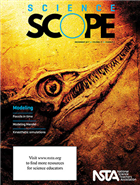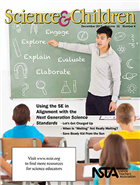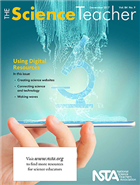Ideas and inspiration from NSTA’s December 2017 K-12 journals
By Mary Bigelow
Posted on 2017-12-18
Are you updating your approach to modeling? Aligning lessons between 5E and NGSS? Incorporating digital resources? Regardless of the grade level you teach, this month’s journals have ideas that can be used or adapted.
 Science Scope – Modeling
Science Scope – Modeling
From the Editor’s Desk: No Glue Required “Models can include diagrams, drawings, physical replicas, mathematical representations, analogies, and computer simulations (NSTA 2014). Regardless of the model used, the key is to engage students in making explanations and predictions—vastly different activities from one in which students merely submit a Styrofoam ball that has been converted into a replica of a cell.”
Articles in this issue that describe lessons include a helpful sidebar (“At a Glance”) documenting the big idea, essential pre-knowledge, time, and cost; many follow a 5E format. The lessons also include connections with the NGSS, and many include examples of student work and classroom materials.
- The series of lessons in Deep Thinking Over Geologic Time: Understanding Fossils and Relative Dating helps students identify relationships between rock layers and learn how scientists use fossils and rock layers to understand the history of the Earth.
- Not all models are three-dimensional. Using Imagery Support Strategies to Develop Powerful Imagistic Models discusses and has an example of how mental models (aka imagery, visualization, spatial thinking) can support learning content and scientific thinking.
- Modeling Mendel: Using a Puzzle-Solving Activity to Develop Ideas About Genetics goes beyond directions for Punnett square to presenting Mendelian genetics as puzzles to be solved.
- Revive your lesson on cellular structures and functions by Engaging All Students in Science Practices Through a Cell Modeling Lesson and creating explanatory models rather than replicas.
- Constructing Scientific Models Through Kinulations shows how students can take on actives roles and cooperatively act out concepts and phenemona (Kinesthetic + simulation).
- Classic Lessons 2.0: Explaining Patterns in Our Solar System and the Role of Gravity in Space includes activities that use modeling to explain patterns in the Solar System.
- Teachers’s Toolkit: Science Can Be a Piece of Cake! has a description of using analogies to explain concepts and phenomena (with examples of students’ work).
- With the resources in Citizen Science: Did You Feel It?, students learn more about earthquakes in real time, use data to predict and model where earthquakes may occur, and create and text earthquake models.
- The 5E lesson in Disequilibrium: Wildfires, the Fire Triangle, and CO2 Extinguishers models a fire extinguisher to help students understand what is necessary for a fire to burn and how to extinguish or mitigate a fire.
- The author of Teacher To Teacher: Creating Conceptual Storylines discusses a narrative approach to learning that can include models and developing investigations.
These monthly columns continue to provide background knowledge and classroom ideas:
- Listserv Roundup: Technology Tools for Paperless Homework
- Science for All: Using Formative Assessments to Differentiate Instruction
- Scope on the Skies: Star Chart
For more on the content that provides a context for projects and strategies described in this issue, see the SciLinks topics Analemma, Buoyancy, Carbon Dating, Cell Structures, Cellular Respiration, Chemical Reactions, Circulatory System, Density, Earthquakes, Fire Extinguisher. Fire Triangle, Fossils, Grand Canyon, Half-Life of Radioactive Isotopes, Identifying Rocks and Minerals, Law of Superposition, Mendelian Genetics, Organelle, Photosynthesis, Relative Dating, Rocks, Solar System, Sound, Spectrum, Stars, Systems.
 Science & Children – Using the 5E in Alignment with the NGSS
Science & Children – Using the 5E in Alignment with the NGSS
Editor’s Note: Developing Coherent Lessons With the NGSS and 5E: ” In combination, the research-based NGSS and 5E provide us with opportunities for creating lessons containing learning progressions, a teaching sequence, coherence in instruction, and assurance of integration—the key components of science learning and assessment of student performance… Using the 5E as the structure and the NGSS for guidance in selecting the concepts and skills provides a strategy for developing lessons that can be used with confidence.”
The lessons described in the articles have a chart showing connections with the NGSS and many include classroom materials and illustrations of student work.
- The charts in Generating Clean Water illustrate the connections between 5E and Engineering Design cycles. The authors include an example of a lesson in which students use their understanding of the water cycle to create a water filtration tool. Engineering Encounters: What’s The Buzz on Bees? also integrates engineering design with science inquiry, in the context of a real-life study of bees and pollination.
- Let’s Get Charged Up adds a sixth E to the model (Express), incorporating a formative assessment probe to check on student understanding. The 6E lesson focuses on designing and creating electric circuits. (also see Formative Assessment Probes: Embedding Formative Assessment Into the 5E Instructional Model)
- Kindergarten students explore forces and engineering design with the activities in Oh No, Henrietta Got Out!, including one with a mini-robot.
- Save Beady Kid From the Sun guides students through an investigation of light energy transfer from the sun and an understanding of experimental design.
- When Is Melting Not Really Melting? describes a lesson in which students explore physical properties of matter using Silly Putty culminating in evidence-based explanations.
- Explore and investigate weather phenomena with the lesson ideas in The Early Years: Using the 5Es to Teach Seasonal Changes.
- Teaching Through Trade Books: Codes and Communication has two lessons in which students consider communications using simple code systems and modern communications.
- Are lessons simply a collection of activities? Methods and Strategies: What’s the Story? explains structural and conceptual coherence and how to build storylines around disciplinary core ideas.
These monthly columns continue to provide background knowledge and classroom ideas:
- Science 101: Why Do You Add Salt When Making Homemade Ice Cream?
- Science 102: Ghostly Visions
- The Poetry of Science: Learning About Trees With the 5Es
- Teaching Teachers: Assessing Students as Scientists
For more on the content that provides a context for projects and strategies described in this issue, see the SciLinks topics Electric Current, Forces, Forces and Motion, Honeybees, Identifying Trees, Light, Morse Code, Parts of a Plant, Physical Properties of Matter, Pollination, Radiation from the Sun, Seasons, States of Matter, Ultraviolet Radiation, Water Cycle, Water Quality.
 The Science Teacher – Using Digital Resources
The Science Teacher – Using Digital Resources
Editor’s Corner: Smartphones: Challenge or Opportunity? “Smartphones are here to stay, and they will only become smarter. What is far less certain is whether we can reimagine our classrooms and instructional practices to take advantage of this powerful new tool.”
The lessons described in the articles include connections with the NGSS and many include classroom resources and illustrations of student work.
- Creating Science Websites can be an engaging way for students to share their learning and ideas. The authors suggest tools, techniques and rubrics.
- The 5E lesson in Making Waves incorporates data from a classroom seismograph (or an online station).
- Connecting Science and Technology shows how to create and use historical short studies as case studies to investigate the history and nature of science.
- The series of lessons in Learning Lichens guide students in a study of these organisms in the lab, in the field, and as air quality monitors.
- For each of the NGSS science and engineering practices, the authors of Idea Bank: Using Apps That Support Scientific Practices describe several apps.
- Using art to communicate is the basis for Idea Bank: The Art of Chemistry.
These monthly columns continue to provide background knowledge and classroom ideas:
- Science 2.0: Choosing a 3-D Printer
- Focus on Physics: Radiant Energy and Global Warming
- Career of the Month: Social Media Manager
- Right to the Source: How the Telegraph Changed the World
For more on the content that provides a context for projects and strategies described in this issue, see the SciLinks topics Acids and Bases, Biodiversity, Chemical Reactions, Earthquakes, Earthquake Measurement, Electromagnetic Waves, Global Warming, Greenhouse Effect, History and Nature of Science, Lichens, Plate Tectonics, Renewable Sources of Energy, Ring of Fire, Sustainability, Symbiosis.
Disclaimer: The views expressed in this blog post are those of the author(s) and do not necessarily reflect the official position of the National Science Teaching Association (NSTA).


